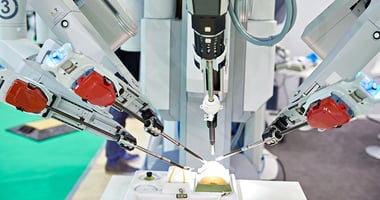Collaborative robots (“cobots”) is the fastest growing segment in industrial automation. Cobots...
The Rise of Robots: The State of the Global Robotics Industry
From its beginning as a relatively simple machine to help people transport heavy equipment to the current iterations that include artificial intelligence and the capability of performing tasks without human assistance, applications for this technology continue to evolve at a robust pace. In this article, we take a look at the current and anticipated future state of the industry and the many uses for robots that have evolved.
The global market value for all robotics applications in 2020 was $27.73 billion. Despite the COVID-19 pandemic, sales did increase slightly with the debut of new robotics applications like cleaning and disinfection robots. Fueled in large part by Asia's continuing rapid deployment of robotics installations (71% of all newly deployed robots in 2020), experts expect double-digit growth to resume and the global market value to be $74.1 billion by 2026 -- an anticipated compound annual growth rate of 17.4% for the period 2021 – 2026.
The robotics market has two main segments, industrial and service. The primary end-users of industrial robots are the automotive, food and beverage, and electronics industries. The primary uses of service robots are logistics, military and defense, and medical and healthcare.
Food and Beverage
One common robotics application in food and beverage is picking and packaging randomly oriented and distributed food products on a conveyor through robot vision. A robotics vision system enables the machine to identify, navigate, inspect and handle components by means of a camera connected to a computer that interprets what the robot "sees." Others include de-panning (i.e., removal of baked goods such as cakes from large pans) of baked goods for packaging, de-nesting (i.e., removal of an empty package from a stack) in conjunction with de-panning, boxing, palletizing, and warehousing.
Labor shortages and food safety in light of the pandemic will be the drivers of future robotics applications in food and beverage. We can expect the use of smaller collaborative robots, or "cobots," to be more prevalent in this industry for smaller producers with less volume. Robots with "soft grip" technology will enable the handling and packaging of irregular and more fragile food products. The goal is to eliminate as much human contact with food and beverages to mitigate airborne illnesses and byproduct contamination.
Electronics
Electronics manufacturers use the Selective Assembly Compliance Robot Arm (SCARA), the 6-Axis Articulated Arm, and the Delta and Cartesian robots. SAARAs and 6-Axis robotic arms operate with high precision and speed. Delta robots assemble, pick, and pack at high speed with good repeatability. More suited to small businesses, Cartesian robots take up less space, are cheaper, and more multi-purpose/customizable than the others, but can work on only 3 axes.
An emerging use for robotics in electronics manufacturing is in the automated optical inspection of products. Mounted cameras can check for proper assembly, alignment, and soldering of components, and infrared cameras can check for thermal issues with the circuitry. The current shortage of electronics components surely will spur more automation to help in production.
Logistics
The main uses for robots in logistics are automated container unloading, goods movement by autonomous vehicles, and sorting of letters and parcels. The increased use of robots in logistics and supply chain applications is due to three factors. The first is the shrinking percentage of working-age people. In many countries, the working-age population will be 50% by the middle of this century (down from 70% at the end of the last century). This will make filling highly repetitive or physically demanding jobs harder to fill. The second is demand for same-day and next-day delivery of goods due to e-commerce. The third is technological advancements that are making robots cheaper and more capable, as well as the cost of advanced sensors that allow robots to detect and adapt to changes quickly. The development of new user interfaces and platforms with better artificial intelligence in the future will mean less time and expense to "teach" robots new tasks. As in other use cases, the goals are increased speed and accuracy and reduced costs, errors, and risks to humans.
Military and Defense
The robotic application that most people probably know about is the Unmanned Aerial Vehicle ("UAV") or drone. Military drones have flown thousands of missions from reconnaissance to strategic strikes. There are over 7,000 drones in military service in the U.S. The drone operators can pilot these drones from secure locations hundreds, and even thousands, of miles away. In 2009, the Army announced its Future Vertical Lift ("FVL") program. The goal of FVL is to deploy long-range assault and attack and reconnaissance UAVs that operate more independently with greater mission parameters by 2030.
The Army also uses robots for bomb disposal and ground-based reconnaissance. Boeing has even developed an unmanned, underwater reconnaissance vehicle. In fact, the Army is developing entire classes of robots for use on the battlefield, including tanks and artillery vehicles.
Medical
The value of the global robotics market for medicine was $7.24 billion. By next year, experts predict the value to be $20 billion. Today, robots can provide a "telepresence" where on-call specialists can view and consult with healthcare professionals in rural/remote areas who are performing procedures and providing therapy. Surgical assistant robots enable surgeon who is seated at a workstation outside of the operating room to manipulate a highly sophisticated robotic arm to conduct minimally evasive procedures. As 3DHD technology advances, surgeons will have enhanced natural stereo visualization combined with augmented reality to perform more complex operations.
Rehabilitation robots help patients recover from strokes, traumatic brain or spinal cord injuries, and neuromuscular diseases like multiple sclerosis. Medical transportation robots can deliver supplies, medications, and meals to patients and staff. In the immediate future, there is a need for cost-effective indoor navigation systems based on sensor fusion location technology in order to improve the navigational capabilities of these robots. Other uses of robots in medicine include sanitation and disinfection, and prescription dispensing.
Healthcare
As the U.S. population ages, the availability and affordability of home healthcare have become a national issue. According to estimates by the U.S. Census Bureau, at the present rate of population growth, seniors will outnumber people under 18 in this country by 2035. The average life expectancy at birth for males in America is 76.1 years and for females 81.1 years (2021 data). The average cost of a private room in a nursing home in 2021 was $8,821.00 per month ($290.00/day) and of a semi-private room $7,756.00 per month ($255.00/day). Assisted living averages about half that, at $4,000.00 per month. Rates in both types of facilities increase for specialized memory care and additional services for some disabilities.
One company offering robotic home healthcare is Comfort Keepers of Reston, VA. Its multi-functioning robot companion known as "Rudy" can perform injections, wound care, ostomy care, and more. Rudy the robot is about the height of 10-year-old and can help seniors in several other ways through simple voice commands. Rudy can illuminate dark areas, call for help, carry things, set reminders, assist patients who need to use the restroom, and call family members or loved ones. Nurses or family members can even take control of Rudy and drive it around a senior's home using an app. At a cost of around $5,000.00, it is comparable to the cost of a human home health worker.
Automotive
The automotive industry uses robots to handle and weld parts on an assembly line, to paint vehicles, assemble smaller components like pumps and motors, install windshields and wheel mounting, cut and trim plastics and fabrics, polish molds, pour molten metal, and transfer metal stamps.
In the not-too-distant future, we can expect robotics and artificial intelligence to enable automated or self-driving vehicles with 3D mapping and road traffic data. 3D printing will become a more sustainable process that will include recycling and will be more common in automotive manufacturing.
With advancements in machine learning and computer vision technology, future home healthcare robots will be more personalized to support patients in daily life. These robots also reduce or eliminate on-the-job hazards home healthcare workers face, such as sharp object injuries, harmful exposures to chemicals and drugs, back injuries, latex allergy, violence, and stress.
The robotics market seems almost unlimited, with new applications in testing and development increasing each year. Robots will continue to change our world.
Image courtesy of STATISTA



